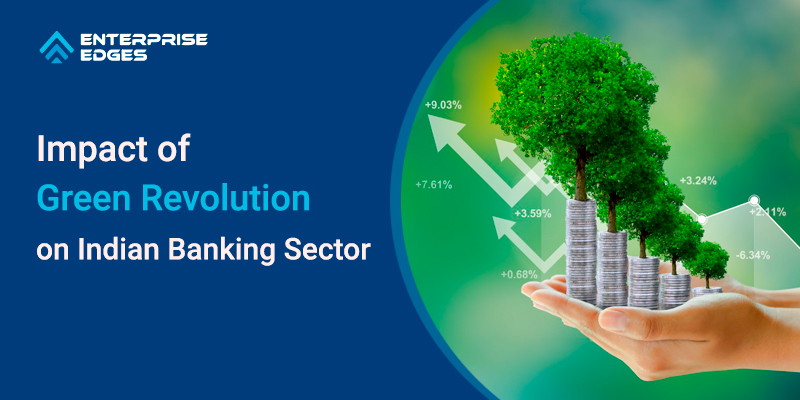Green banking is a recent phenomenon in the financial industry. The function of banks in financing economic and developmental activities is crucial for advancing overall sustainable development. The term “green banking” is one that banks use to describe their increased environmental responsibility. Creating inclusive banking policies that would guarantee sustainable economic development is referred to as “green banking.” By guaranteeing environmentally friendly practices in the banking industry, internal and external carbon footprints can be reduced. The banking industry, it makes technological advancements, operational improvements, and changes in customer behaviors. The old banking system in India has been altered by recent advancements in banking technology into a more inclusive one that considers the interests of clients, the bank, and the environment.
Digital Banking Trends And Technologies For Better Banking
What is a Green Economy?
The phrase refers to a low-carbon, resource-efficient, and socially equitable economy. Growth in employment and income in a green economy is driven by the infrastructure and resources that enable reduced carbon emissions and pollution, greater energy and resource conservation, and the prevention of the depletion of biodiversity and ecosystem services. A green economy is characterized by investments in renewable energy sources like solar electricity, onshore and offshore wind power, hydrogen, electric vehicles, and energy-efficient housing. The concept of a “green economy” does not replace sustainable development; rather, it places a fresh emphasis on the economy, investment, capital, infrastructure, jobs, skills, and positive social and environmental outcomes.
Importance of Green Financing:
To achieve some of its Sustainable Development Goals, green financing is crucial. When planning approval, strategic priorities, and capital are combined in the correct way, clean energy sources can become a reality. To make such projects more appealing than, say, energy infrastructure created from fossil fuels, they might receive preferential status.
Typical projects covered by the term “green finance” include:
- Energy efficiency and renewable energy
- Reducing and preventing pollution
- Conserving biodiversity
- Initiatives for a circular economy
- Sustainable use of land and natural resources
Green Revolution and Indian Banking:
The Green Revolution in India has had a tremendous impact on the banking sector, altering its regulations, practices, and reach. The emphasis placed during the revolution on agricultural development necessitated a large expansion in agricultural lending as well as the introduction of specific loan products. As a result, rural banking increased as banks opened locations and branches in unexplored regions, boosting the economies of small towns.
Financial inclusion was extremely important during the Green Revolution due to the establishment of microfinance institutions that provided credit and other financial services to small and marginal farmers. The banking sector recognized how important it was to reach out to these underrated populations and develop innovative financial products to meet their needs.
The Green Revolution led to advancements in both financial and agricultural technologies. Through the use of technology, banking procedures have become more efficient and have improved access to financial services in rural areas. Due to the digitization of financial channels, which has also boosted convenience, farmers and rural populations now have greater access to banking services.
Sustainability became a key consideration in the banking business when concerns about the environmental effects of intensive farming methods were made public by the Green Revolution. Banks started promoting and funding organic farming, sustainable farming practices, and renewable energy initiatives in an effort to align their business practices with environmental conservation objectives.
Effect of the green banking sector in the Indian banking sector:
The IPCC correctly asserted that there is no conclusive scientific information regarding how the effects of climate change will influence the banking industry. The concerns of climate change have been examined from the perspectives of financial risk and stability by central banks, regulators, and the academic community, even if there may not be conclusive scientific proof. Three main financial risk variables are linked to climate change. They are:
- Physical
- Transitional
- Liability
Physical risks:
- Physical risk is described as the first-order risks brought on by climatic and meteorological occurrences, such as floods, storms, heat waves, droughts, and sea level rise, coupled with the susceptibility of exposed natural and societal systems.
- Physical dangers can lower asset prices, increasing credit risk and financial losses.
Transitional risks:
- Transition risks are those that might appear because of the frequently disorganized adjustment to a low-carbon economy.
- Many different types of assets run the danger of being stranded because climate change mitigation measures frequently necessitate dramatic changes and adaptations by the public and corporate sectors as well as families. This is particularly true for industries and assets associated with fossil fuels, which might result in higher credit exposure for banking and non-banking financial institutions in the event of a revaluation.
Liability risks:
- Liability hazards can also be a significant source of financial risk.
- If persons who have suffered losses because of climate change seek compensation from those they hold responsible, liability concerns may result.
- Due to the way they are compensated and the nature of the risks, liability concerns may apply more to the insurance industry than to the banking industry.
Conclusion:
As a result of the Green Revolution, the Indian banking industry is now more diverse, cutting-edge, and environmentally concerned. The industry is still developing, adjusting to the shifting agricultural landscape, and making sure that it continues to be a significant driver of prosperity and growth for Indian farmers and rural communities. The industry can further contribute to the overall prosperity of the agriculture sector and the nation by integrating banking practices with sustainable development.
